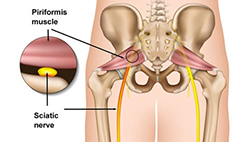Piriformis Syndrome Palos Hills and Mokena

Piriformis syndrome is a condition in which the piriformis muscle, located behind the gluteus maximus, spasms and causes pain in the buttock. The piriformis muscle is small and located deep in the buttock, connecting to the top of each femur. Its purpose is to rotate the hip and turn the leg and foot outward. (Spine Health)
Piriformis syndrome can cause irritation of the sciatic nerve, which runs around the piriformis muscle. This causes pain, tingling, and numbness down the leg and foot. Symptoms are similar to sciatica, but piriformis syndrome is not classified as sciatica.
Symptoms & Causes
Symptoms of Piriformis Syndrome include:
- Muscle spasms
- Muscle tightening
- Muscle swelling
- Pain in buttock after sitting for 15-20 min
- Pain in legs and buttock after walking, running, or going up stairs
- Reduced hip mobility
Symptoms can be more painful after long physical activities. In some cases, the pain will be relieved after lying on your back. Pain or tingling may also extend down the leg and calf. (Spine Health)
Causes of Piriformis Syndrome include:
- Pressure on the sciatic nerve
- Overuse, injury, or strain of buttock muscles
- Piriformis muscle spasms and tightness
While there are many similarities between piriformis syndrome and sciatica, one major difference is that piriformis syndrome is not rooted in a spinal problem. When the Piriformis muscle spasms, it places pressure on the sciatic nerve which causes pain. The sciatic nerve runs very close to the piriformis muscle, and in 10 percent of the population, the nerve actually runs through the muscle fibers. (Sports Injury Clinic)

Common Misconception
There is one common misconception about piriformis syndrome. Many assume that piriformis syndrome is caused by a problem with the spine. Sciatica, which has many of the same symptoms, can be caused by four different spinal conditions: Lumbar Herniated Disc, Degenerative Disc Disease, Isthmic Spondylolisthesis, and Lumbar Spinal Stenosis.
Piriformis syndrome is different in that it is caused by the buttock muscles and hip joints, rather than a pinched nerve. Many also assume that piriformis and sciatica are one and the same, but piriformis syndrome is not classified as sciatica.
Non-Surgical Treatments
Treatment of piriformis syndrome should first focus on relieving pain, then strengthening the piriformis muscle. For short-term pain and muscle spasms, place an ice pack on the area for relief. If the pain lasts longer than 2-3 weeks and the muscles continue to spasm, use heat to relieve muscle pain over time. (Sports Injury Clinic)
Following pain relief treatment, physical therapy may be recommended to alleviate and prevent future injuries. Recovery time varies for each person depending on the severity of their piriformis syndrome.
Non-surgical treatments for piriformis syndrome include:

- Ice or heat
- Electrotherapy
- Massage
- Stretching
- Anti-inflammatory medication
- Botox injection
- Piriformis injection
- Rest from physical activities
Surgical Treatments
While most cases of piriformis syndrome go away on their own, surgery is an option for those who cannot find pain relief and therefore cannot perform normal activities. Surgery can be performed to cut the piriformis muscle in order to release pressure on the sciatic nerve. (MedicineNet)
Recovery
Recovery from piriformis syndrome should include strengthening stretches and exercises to prevent re-injury. Stretches should be held for 30 seconds and repeated 5 times in one session. Foam rollers may also be used to release tension in the piriformis muscle. As part of our physical therapy program at MidAmerica Orthopaedics, patients learn how to properly bend, stretch and lift in order to build strength and avoid re-injury.
Your Next Step
Dr. George E. Charuk
Physical Medicine and Rehabilitation Specialist, Dr. George E. Charuk, treats conditions of the neck and lower back (including sciatic nerve pain) using a comprehensive program of minimally invasive, non-operative, and physical therapy techniques.
Procedures performed by Dr. Charuk include epidural steroid injection, facet injection, sacroiliac joint injection, radiofrequency ablation, and prolotherapy.
Dr. Charuk and his team customize a course of treatment for each patient based on their specific needs and medical history. Ultimately, the goal is to help you feel better and resume your normal activities using the combination of treatments that best suits your unique situation.

To learn more about MidAmerica Orthopaedics and the different treatment options available to you, visit our website.
To schedule an appointment with MidAmerica Physical Medicine and Rehabilitation Specialist, Dr. George Charuk, call (708) 237-7200. You can also request an appointment online.

